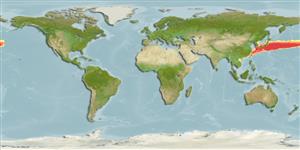Classification / Names
Nombres comunes | Sinónimos | Catalog of Fishes(Género, Especie) | ITIS | CoL | WoRMS | Cloffa
>
Stomiiformes (Lightfishes and dragonfishes) >
Stomiidae (Barbeled dragonfishes) > Melanostomiinae
Etymology: Eustomias: Greek, eu = good + Greek, stoma = mouth (Ref. 45335).
Environment: milieu / climate zone / depth range / distribution range
Ecología
marino batipelágico; rango de profundidad 0 - 932 m (Ref. 34246). Deep-water
Northwest Pacific: southeast of Japan.
Tamaño / Peso / Age
Maturity: Lm ? range ? - ? cm
Max length : 12.1 cm SL macho / no sexado; (Ref. 34246); 12.1 cm SL (female)
Short description
Claves de identificación | Morfología | Morfometría
The single-based branch of the barbel arises from the stem; the branch with many elaborate, branched side filaments throughout most of its length with the proximal filaments arising just distal to the main branch origin. Most of the barbel stem unpigmented between branch and terminal bulb (Ref. 34246).
Life cycle and mating behavior
Maturities | Reproducción | Spawnings | Egg(s) | Fecundities | Larva
Clarke, T.A., 1999. Pelagic fishes of the genus Eustomias (Melanostomiidae) similar to Eustomias dendriticus Regan and Trewavas with the description of seven new species. Copeia 1999(4):1002-1013. (Ref. 34246)
IUCN Red List Status (Ref. 130435)
Threat to humans
Harmless
Human uses
Herramientas
Special reports
Download XML
Fuentes de Internet
Estimates based on models
Preferred temperature (Ref.
123201): 0.9 - 18.7, mean 11.5 °C (based on 63 cells).
Phylogenetic diversity index (Ref.
82804): PD
50 = 0.5000 [Uniqueness, from 0.5 = low to 2.0 = high].
Bayesian length-weight: a=0.00302 (0.00117 - 0.00783), b=3.12 (2.89 - 3.35), in cm total length, based on LWR estimates for this (Sub)family-body shape (Ref.
93245).
Nivel trófico (Ref.
69278): 4.1 ±0.7 se; based on size and trophs of closest relatives
Resiliencia (Ref.
120179): Medio, población duplicada en un tiempo mínimo de 1.4-4.4 años (Assuming tmax>3).
Fishing Vulnerability (Ref.
59153): Low vulnerability (10 of 100).
